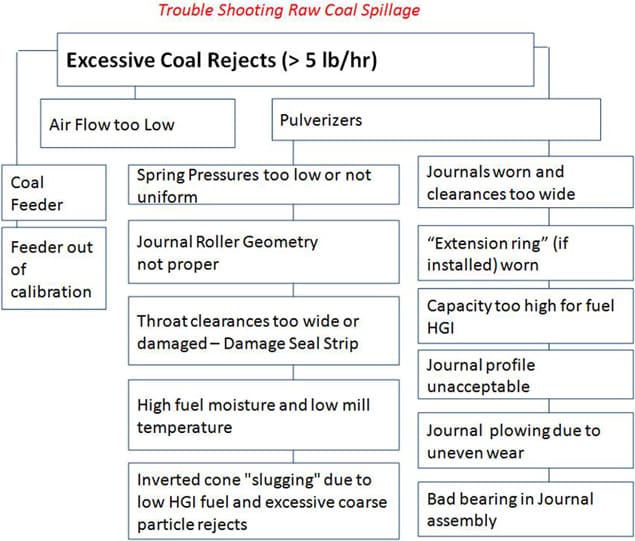
 Pulverizer spillage describes the condition when raw or partially pulverized coal passing over the edge of the bowl falls through the vane wheel or pulverizer throat to be rejected through the pyrite chute. No or miniscule amounts of coal should be discharged through the pyrite chute. As it name implies, the pyrite chute is for discharging pyrites and tramp iron. The term “pyrites” refers to a compound typically contained in coal deposits that is a combination of Iron and Sulfur (FeS2). It is also commonly called “fools gold” because it can be shiny and similar in appearance to gold.
Pulverizer spillage describes the condition when raw or partially pulverized coal passing over the edge of the bowl falls through the vane wheel or pulverizer throat to be rejected through the pyrite chute. No or miniscule amounts of coal should be discharged through the pyrite chute. As it name implies, the pyrite chute is for discharging pyrites and tramp iron. The term “pyrites” refers to a compound typically contained in coal deposits that is a combination of Iron and Sulfur (FeS2). It is also commonly called “fools gold” because it can be shiny and similar in appearance to gold.
With respect to coal pulverizers, the term pyrites usually refers to any material rejected from the pulverizer including the compound pyrite as well as “tramp” metal, rocks, clay and other debris.
Small pieces of tramp iron are also discharged through the pyrite chute. Tramp iron refers to pieces of metal that enter the pulverizer that were contained in the raw coal. Typical tramp iron includes railroad spikes, bolts, nuts, tools, scrap steel and other metallic debris. Tramp iron may have come from the mine or entered the raw coal during transport or at the plant. All efforts are usually made to minimize the amount of tramp metal that enter the pulverizer. Metal can not be pulverized and will place undue stresses on the pulverizers bearings, main shaft, journals and bull ring. Larger pieces of tramp metal have been known to dislodge or break bull ring segments, clamping rings and vane wheel segments resulting in significant damage to the pulverizer.
Even though several variables can cause or exacerbate spillage, the root cause of coal spillage is that the air passing through the vane wheel annulus does not have enough energy to maintain suspension of the coal particles. Under normal conditions, air velocity across the vane wheel annulus must be in the range of 7,000 Fpm to 7,500 Fpm to maintain suspension of raw coal between ¼” to 1” in size.
When coal particles are discharged from the pyrite section of a pulverizer, this indicates that the air passing through the vane wheel did not have adequate energy to suspend the coal and transport it to the upper section of the pulverizer. Pulverizer spillage is usually caused by air velocity across the pulverizer throat that is too low (<7,000 Fpm) to prevent coal from spilling through the throat annulus into the pulverizer pyrite section. Air velocity across the vane wheel annulus must be in the range of 7,000 Fpm to 7,500 Fpm to maintain suspension of raw coal of ¼” to 1” in size. In some cases spillage can be aggravated by or caused by other variables. Some of these variables include:
Pulverizer throats that are not properly sized or have been enlarged by wear may result in serious coal dribble or spillage. Coal dribble or spillage is raw coal that is rejected through the pulverizer’s pyrite discharge. This is caused when the velocity across the pulverizer throat is too low to maintain suspension of coal. Air velocities through the pulverizer throat should be 7,000 to 7,500 Fpm when calculated on a free jet basis. Air at velocities above 7,000 Fpm will have sufficient energy to prevent coal from falling through the throat and will carry coal to the classifier or back to the grinding zone. The sketch below illustrates the location where “throat” velocity must be >7,000 Fpm to prevent raw coal spillage.


No raw coal should be discharged through the tramp metal or “pyrite” chute. Photo illustrates only rocks and metallic debris being discharged from the pyrite area.
